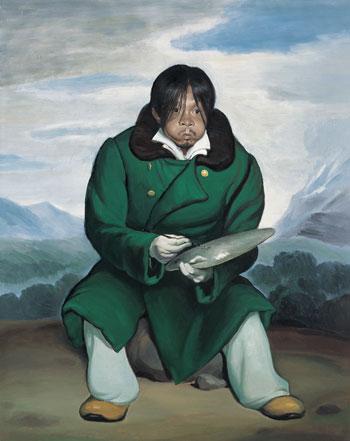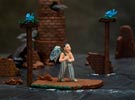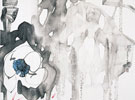
展览时间:2011-11-05 ~ 2012-02-12
展览地点:麦勒画廊
参展艺术家:王兴伟、程然
开幕时间:2011-11-05 16:00~19:00
展览介绍:
麦勒画廊高兴地向您宣布我们将于2011年11月5日举办艺术家王兴伟(1969年生于中国沈阳,生活和工作在中国北京)的近期绘画作品展和程然(1981年生于中国内蒙古,生活和工作在中国杭州)的影像作品展《热血、温血、冷血》。
王兴伟并非出自艺术世家,然而出于对绘画天生的喜爱,他走上了艺术之路。上世纪80年代的终结意味着王兴伟正式开始他的绘画创作。自90年代中期起,王兴伟开始在艺术实践中使用丰富的文化及历史元素,对各种观念、风格,及形式进行着大量的实验;作品扎实有力,又不乏诙谐。
如今的王兴伟,已不再是当年那个穿着手织毛裤的文艺青年。通过多年来在艺术上的坚持与不断的绘画实践,王兴伟建立了一套庞大、繁杂,而独特的绘画语言体系,也极大地拓展了绘画的内涵。在他的绘画作品中,每个元素之间虽然看起来并无关联,但又都是进入艺术家“视觉字典”的重要“词条”及线索。这些并置的元素通过其巨大的力量、以及无法预见的可能性有意地打破了人们惯常的思维与知识逻辑。
此次展览将展出王兴伟自2007年至今的近20幅绘画作品。根据麦勒画廊的空间,展览将分为“室内”和“室外”两个部分。在“室外”部分中,观众不仅可以看到王兴伟的肖像作品——艺术家笔下的同行兼好友《毛焰》(2010),也可以看到王兴伟少见的传统写生作品《电影博物馆旁里的大树》(2011)。在陈列“室内”作品的展厅中,观众将得以通过内容相近的“老太太”系列作品近距离观看王兴伟绘画作品的演化和递进过程。策展人张离这样评价,“这些作品只是展现了一种生动复杂的被称为绘画的艺术方式。”
程然的影像作品展《热血、温血、冷血》将与王兴伟的个人绘画展同时开幕。该展览以程然最新的三屏高清彩色有声录像作品命名。在该作品中,艺术家将用影像语言分别展现马的三种性格——热血、温血,和冷血。
值得注意的是,这个三屏同步播放的录像作品并非一个以观念为主的作品,艺术家希望将技术对作品的影响降至最低。程然甚至乐意用错误的剪接来呈现一种有象征主义的形式感及美的镜头,从而表现一个未知的影像空间。
在一份未发表的艺术家自述中,程然这样写道,“热血、温血、冷血暗示和象征了马的三种性格,不可见的,关于情感,精神状态中向不同的方向漂移,并不稳定和确切,却也如人的精神世界,并不可触及,却不可或缺。”
王兴伟和程然身为不同年代的艺术家,创作的媒介及艺术语言也各不相同。我们希望两位艺术家的个人展览可以为观众带来不同的视觉体验与感悟。
Galerie Urs Meile is pleased to announce the opening of a solo exhibition of Wang Xingwei’s (*1969 in Shengyang, China; lives and works in Beijing, China) recent works, as well as Cheng Ran’s (*1981 in Inner Mongolia, China; lives and works in Hangzhou, China) Hot Blood, Warm Blood, Cold Blood.
Wang Xingwei does not come from an artistic family. It was a natural-born love of painting, rather than his background, that led him to become an artist. The end of 1980s marked the official start of his career as a painter. Since the mid-1990s, his artistic practice, which is rich in subtle cultural and historical references, has been defined by the concurrency of diverse conceptual, stylistic and formal experimentations.
Wang Xingwei is no longer the artistic youth that was known for wearing hand-knitted woollen trousers. He has constructed an exquisitely unique and picturesque language of seemingly disconnected elements - conceptual entries from his own “visual dictionary”. These elements are juxtaposed in order to purposely dismantle the acknowledged logic of thinking and create, by means of their disruptive power, new and unpredictable interpretative possibilities.
This exhibition will show a collection of nearly 20 of Wang Xingwei’s paintings from 2007 up until the present day. The exhibition has been divided into two parts in accordance with the parameters of the exhibition space – Indoor Views and Outdoor Views. The latter will present audiences with the portrait Mao Yan (2010), which depicts the peer and good friend of the artist, as well as Big Tree by the Film Museum (2011), a traditional life study. This is a rare opportunity to view such works, given the artist’s usual approach of working from ready-made images. The Indoor Views space will investigate the continuous evolution and progression of the artist’s Old Lady series, which consists of a number of very similar works. As the curator Zhang Li said: “They present a lively, complex art form, the one we call ‘painting’.”
Cheng Ran’s solo show, Hot Blood, Warm Blood, Cold Blood will open at the same time. The exhibition will present a video work of the same title – a 3-channel colour video with sound, in which the artist demonstrates 3 characteristics of the horse – hot blood, warm blood, and cold blood.
It is important to note that Cheng Ran’s 3-channel video work is not primarily a conceptual work. The artist hopes to reduce the technical influence to a minimum level through the deliberate use of inappropriate editing to demonstrate the formality embraced in symbolism and imagery, thus representing an unknown image-space.
In an early unpublished statement, Cheng Ran wrote that: “Hot blood, warm blood and cold blood signify 3 characteristics of the horse: the invisible elements that drift in different directions of emotional and spiritual states; similar to the spiritual world of human beings, unreachable, but indispensable.”
Wang Xingwei and Cheng Ran represent two different ages. The media and artistic language that they use is also entirely different. We hope to give audiences a new and different visual experience through the concurrent solo exhibitions of these two very different artists.
- 2011-10-22 ~ 2011-12-05平乏中的诗意──乔治·泰斯的摄影作品
- 2011-10-22 ~ 2011-11-20大时代——邓霄个展
- 2011-09-03 ~ 2011-10-02平安的世界——大卫·斯考皮克个展
- 2011-10-28 ~ 2011-11-28“意·境·悟”中国当代禅画名家邀请展
- 2011-11-19 ~ 2011-12-1870s菁锐进行式
- 2011-11-05 ~ 2011-12-22文中言——绘画作品展
- 2011-11-05 ~ 2011-12-05“景界”——洪浩昌油画作品展
- 2011-11-05 ~ 2011-11-30触镜——穿梭异视界
- 2011-10-29 ~ 2011-11-20新山海经——关伟作品展
- 2011-11-05 ~ 2011-11-30无处不在的星辰——牟林童作品




